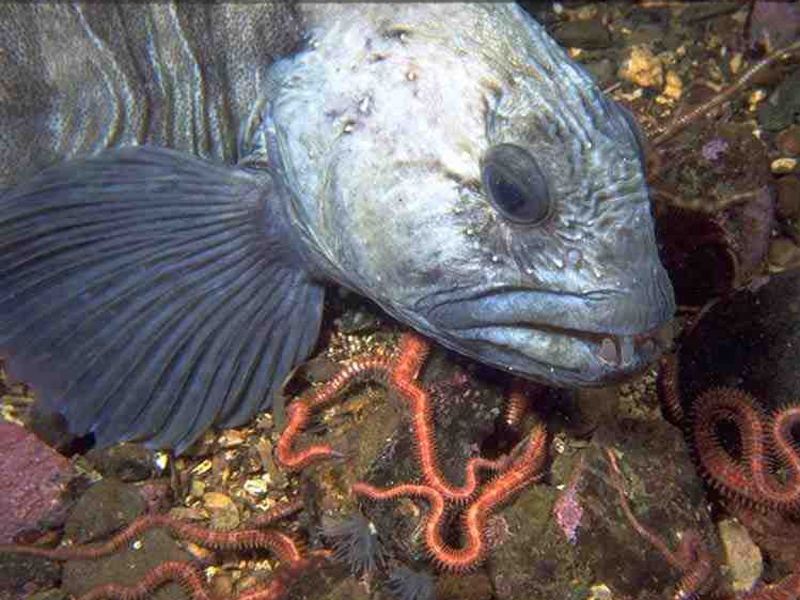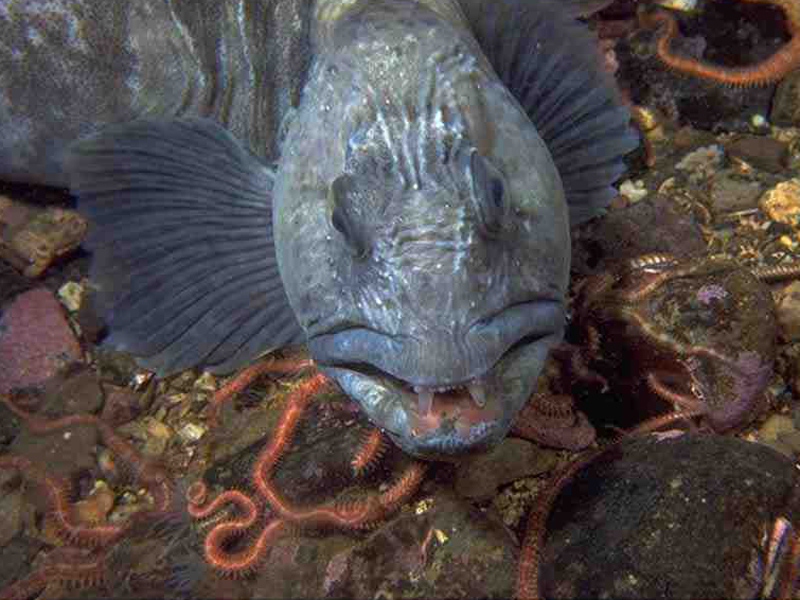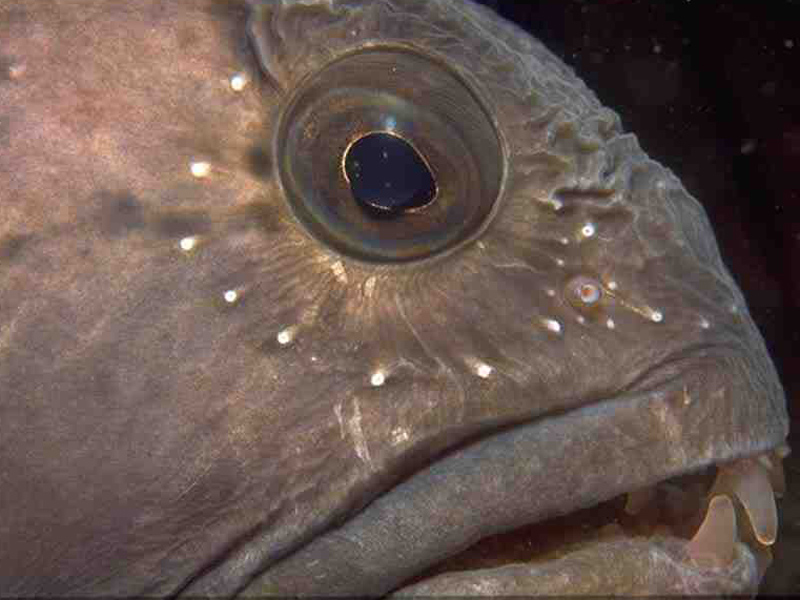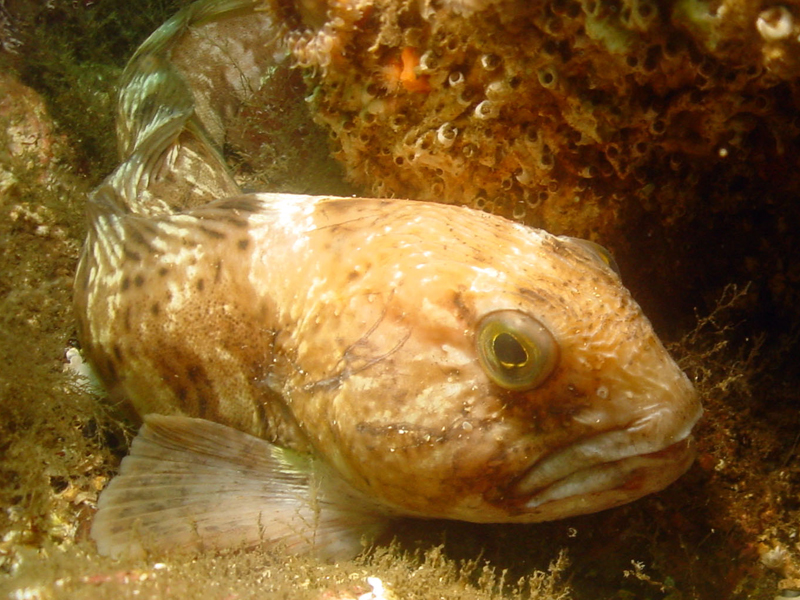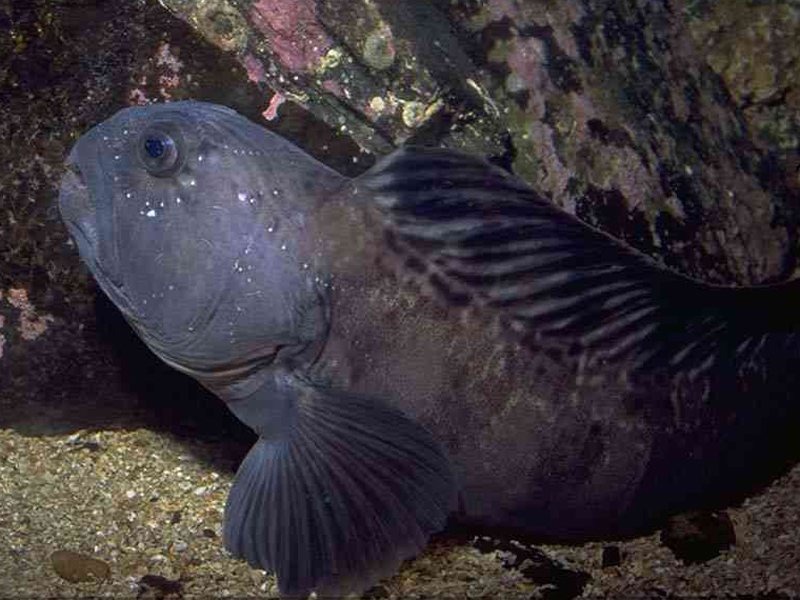Wolf fish or Catfish (Anarhichas lupus)
Distribution data supplied by the Ocean Biodiversity Information System (OBIS). To interrogate UK data visit the NBN Atlas.Map Help
| Researched by | Joelene Hughes | Refereed by | Admin |
| Authority | Linnaeus, 1758 | ||
| Other common names | - | Synonyms | - |
Summary
Description
Recorded distribution in Britain and Ireland
Found on the north coasts of England and Scotland. This species is probably under recorded.Global distribution
Occurs from Scandinavian coasts to the south of France, and northeast from Britain and Ireland to Iceland. Also found in the Arctic Atlantic, the east coast of Greenland and from Labrador to Cape Cod. One record from the Mediterranean.Habitat
The adults are usually found in deep waters, from 100-300 m, but can range to depths of 500 m. Young may be found at 10-30 m and possibly in the Laminaria zone. They are normally found on rocky seabeds where they often occupy fissures and holes with only the head protruding, and they may also be found on sand or mud.Depth range
-Identifying features
- Bluish-grey colouring, possibly with tinges of yellow or green.
- 9-13 dark bars extend across the body to the base of the dorsal fin.
- The head is large, nearly one quarter of the body length.
- Large canine-like teeth protrude from the front of the jaw.
- Teeth on the vomer (a bone forming the front part of the roof of the mouth) reach back further than the lines of palatine teeth either side.
- The caudal fin is rounded with between 22 and 26 rays.
- The pectoral fins are approximately a third of the length from head to anus.
- The dorsal and anal fins stop just short of the tail fin.
Additional information
-none-Listed by
- none -
Bibliography
Costello, M.J., Bouchet, P., Boxshall, G., Emblow, C. & Vanden Berghe, E., 2004. European Register of Marine Species [On-line]. http://www.marbef.org/data/erms.php,
FishBase, 2000. FishBase. A global information system on fishes. [On-line] http://www.fishbase.org, 2001-05-03
Foster-Smith, J. (ed.), 2000. The marine fauna and flora of the Cullercoats District. Marine species records for the North East Coast of England. Sunderland: Penshaw Press, for the Dove Marine Laboratory, University of Newcastle upon Tyne.
MarLIN (Marine Life Information Network), 2005. SEArchable BEnthic Data (SEABED) Map [on-line]. Data Access Sub-programme, Marine Life Information Network for Britian and Ireland http://www.marlin.ac.uk,
Muus, B.J. & Dahlstrom, P., 1974. Collins guide to the sea fishes of Britain and North-Western Europe. Wm Collins Sons & Co. Ltd: London.
Wheeler, A., 1969. The fishes of the British Isles and north-west Europe. London: Macmillan.
Whitehead, P.J.P., Bauchot, M.-L., Hureau, J.-C., Nielson, J. & Tortonese, E. 1986. Fishes of the North-eastern Atlantic and the Mediterranean. Vol. I, II & III. Paris: United Nations Educational, Scientific and Cultural Organisation (UNESCO).
Datasets
Environmental Records Information Centre North East, 2018. ERIC NE Combined dataset to 2017. Occurrence dataset: http://www.ericnortheast.org.ukl accessed via NBNAtlas.org on 2018-09-38
Nature Locator, 2017. Sealife Tracker. Occurrence dataset: https://doi.org/10.15468/qgk3pg accessed via GBIF.org on 2018-10-01.
NBN (National Biodiversity Network) Atlas. Available from: https://www.nbnatlas.org.
OBIS (Ocean Biodiversity Information System), 2025. Global map of species distribution using gridded data. Available from: Ocean Biogeographic Information System. www.iobis.org. Accessed: 2025-07-26
Citation
This review can be cited as:
Last Updated: 15/03/2007

